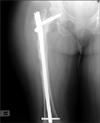Abstract
A broken lag screw of the cephalomedullary nail is a rare condition. Removal of the retained lag screw from the femoral head is also very challenging. This article describes a surgical technique and the modified instrument that was available in the operating room for removing the broken implant by closed technique.
Implant failure is one of the most serious complications in orthopaedic trauma surgery. Many surgical techniques have been reported in the literatures regarding removal of broken implants especially the intramedullary nail from the long bones such as femur and tibia.1,2,3) However, based on our literature review, failure of the lag screw of the cephalomedullary nail and the removal technique have not been presented. We, therefore, report a rare case of broken lag screw of the cephalomedullary nail retained in the femoral head and the surgical procedure for removal.
A 50-year-old female presented with nonunion of right subtrochanteric fracture and broken lag screw of long cephalomedullary nail (30° long IT/ST nail, Zimmer, Warsaw, IN, USA) (Fig. 1). On the day of surgery, the patient was positioned supine on a traction table. Gentle traction was applied to the effected leg by using a foot strap attached to the operating table while the other leg was placed on a leg holder in hemilithotomy position. After removal of the distal screw, lateral end of the lag screw, and the nail respectively by a routine technique, the bonescrew interface was reamed manually by using a trephine reamer (Zimmer Femoral Trephine Set, Zimmer) in a corresponding size with the lag screw diameter about a half way of the retained screw length. The customized removal tool was then applied gently following the tract of the trephine reamer until gripping the broken screw firmly. The broken lag screw was then finally removed by anticlockwise turning the removal tool as a screwdriver. Nail exchange was carried out sequentially by using another long cephalomedullary nail (125° long gamma-3 nail, Stryker, Schönkirchen, Germany). With the difference in angle of the lag screw, a healthy subchondral bone was purchased. As a result of multiple previous revision surgery, iliac bone graft was then applied to enhance the ability of bone healing. Partially weight bearing was strictly advocated on the injured leg for the first 3 months. The fracture united in 7 months without complication (Fig. 2).
A specific socket screwdriver was created by modifying a used 12 × 40 mm Arbeitsgemeinschaft für Osteosynthesefragen (AO) femoral nail and another identical lag screw as a template (Fig. 3). This particular device was then tested on an experimental setting in order to confirm its function prior to surgery.
The overall incidence of Gamma nail breakage is 0.2%-5.7%.4,5,6,7) The most common site of implant failure occurred at the lag screw hole, and the rest occurs along the nail shaft and the distal screw hole, respectively. To our knowledge, no report regarding breakage of the lag screw has been identified. Therefore, this might be the first report of lag screw breakage in Gamma nailing.
Varus reduction and poor biology of healing from multiple revision surgery in this patient may contribute to a failure of construct over times.8) Avoidance of using nail cap, which prevents rotation and excessive sliding of lag screw, probably is another factor of inadequate stability and leads to breakage of implant in this patient.9) Therefore, the planning for another revision surgery is to preserve and enhance the biology of bone healing as much as possible.
Normally, there is no specific instrument to remove a broken lag screw from the femoral head. Using a hooked instrument as an extractor might not be strong enough to overcome the friction at the bone-implant interface. Therefore, the principle to solve this particular problem is to create a socket screwdriver that can grip the broken lag screw firmly enough for removal. By preservation of the femoral head bone stock, the bone-implant interface between the shaft of the lag screw was reamed by using a trephine reamer. The trephine reamer was then replaced with the customized socket screwdriver. After griping the lag screw firmly, the broken lag screw was finally removed without complication. Therefore, this presented technique is simple, safe, and promising.
Figures and Tables
 | Fig. 1Radiograph showed nonunion of subtrochanteric fracture of right femur and breakage of a lag screw of long cephalomedullary. |
References
1. Franklin JL, Winquist RA, Benirschke SK, Hansen ST Jr. Broken intramedullary nails. J Bone Joint Surg Am. 1988; 70(10):1463–1471.
2. Riansuwan K, Carter C, Nercessian O. Removal of broken long gamma nail: a modified guide wires technique. J Trauma. 2008; 64(2):517–519.
3. Whalley H, Thomas G, Hull P, Porter K. Surgeon versus metalwork: tips to remove a retained intramedullary nail fragment. Injury. 2009; 40(7):783–789.
4. Gaebler C, Stanzl-Tschegg S, Tschegg EK, et al. Implant failure of the gamma nail. Injury. 1999; 30(2):91–99.
5. Pervez H, Parker MJ. Results of the long Gamma nail for complex proximal femoral fractures. Injury. 2001; 32(9):704–707.
6. Iwakura T, Niikura T, Lee SY, et al. Breakage of a third generation gamma nail: a case report and review of the literature. Case Rep Orthop. 2013; 2013:172352.
7. Alvarez DB, Aparicio JP, Fernandez EL, Mugica IG, Batalla DN, Jimenez JP. Implant breakage, a rare complication with the Gamma nail: a review of 843 fractures of the proximal femur treated with a Gamma nail. Acta Orthop Belg. 2004; 70(5):435–443.
8. Shukla S, Johnston P, Ahmad MA, Wynn-Jones H, Patel AD, Walton NP. Outcome of traumatic subtrochanteric femoral fractures fixed using cephalo-medullary nails. Injury. 2007; 38(11):1286–1293.
9. Kuzyk PR, Shah S, Zdero R, Olsen M, Waddell JP, Schemitsch EH. A biomechanical comparison of static versus dynamic lag screw modes for cephalomedullary nails used to fix unstable peritrochanteric fractures. J Trauma Acute Care Surg. 2012; 72(2):E65–E70.




 PDF
PDF ePub
ePub Citation
Citation Print
Print




 XML Download
XML Download